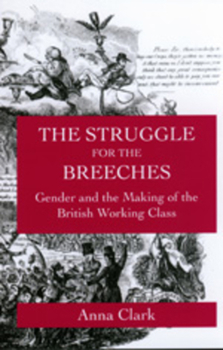The Struggle for the Breeches: Gender and the Making of the British Working Class (Studies on the History of Society and Culture , No 23)
(Part of the Studies on the History of Society and Culture Series)
Select Format
Select Condition 
Book Overview
Linking the personal and the political, Anna Clark depicts the making of the working class in Britain as a "struggle for the breeches." The late eighteenth and early nineteenth centuries witnessed significant changes in notions of masculinity and femininity, the sexual division of labor, and sexual mores, changes that were intimately intertwined with class politics. By integrating gender into the analysis of class formation, Clark transforms the traditional narrative of working-class history.
Going beyond the sterile debate about whether economics or language determines class consciousness, Clark integrates working people's experience with an analysis of radical rhetoric. Focusing on Lancashire, Glasgow, and London, she contrasts the experience of artisans and textile workers, demonstrating how each created distinctively gendered communities and political strategies.
Workers faced a "sexual crisis," Clark claims, as men and women competed for jobs and struggled over love and power in the family. While some radicals espoused respectability, others might be homophobes, wife-beaters, and tyrants at home; a radical's love of liberty could be coupled with lust for the life of a libertine. Clark shows that in trying to create a working class these radicals closed off the movement to women, instead adopting a conservative rhetoric of domesticity and narrowing their notion of the working class.
Going beyond the sterile debate about whether economics or language determines class consciousness, Clark integrates working people's experience with an analysis of radical rhetoric. Focusing on Lancashire, Glasgow, and London, she contrasts the experience of artisans and textile workers, demonstrating how each created distinctively gendered communities and political strategies.
Workers faced a "sexual crisis," Clark claims, as men and women competed for jobs and struggled over love and power in the family. While some radicals espoused respectability, others might be homophobes, wife-beaters, and tyrants at home; a radical's love of liberty could be coupled with lust for the life of a libertine. Clark shows that in trying to create a working class these radicals closed off the movement to women, instead adopting a conservative rhetoric of domesticity and narrowing their notion of the working class.
Format:Paperback
Language:English
ISBN:0520208838
ISBN13:9780520208834
Release Date:April 1997
Publisher:University of California Press
Length:415 Pages
Weight:1.52 lbs.
Dimensions:1.1" x 5.9" x 8.9"
Customer Reviews
1 rating
What defined gender relations in the British Working Class: Economics or Politics?
Published by Thriftbooks.com User , 18 years ago
Building upon E.P. Thompson's definition of the "Working Class" in Britain, Anna Clark has developed a definitive study of the role that gender played in the development of this class during the era of the Industrial Revolution. Her primary argument is that gender played a "profound" role in the development of the Working Class (p. 264), which is a significant enhancement to Thompson's work. To determine whether or not gender did help to define the British Working Class, she evaluated social forces such as marital relationships, sexual morality, and labor. She has further branched out to include an assessment of political radicalization and Chartism in an effort to fully define the effect of gender on the formation of the British Working Class during the Industrial Revolution. The authors' evaluation of marital relationships and sexual morality showed a challenging environment often permeated with husbands violently beating their wives because of their "nagging". Popular literature, such as the tale of "The Bold Cobbler" (p. 71) shows that people widely accepted the concept of male domination in this particular "class" of society, thus demonstrating the importance of gender within the family structure, and, because of the occupation of "cobbler", the link to the working class. Sexual morality differed greatly between the working class and the middle class, but the economics of the working class mandated this difference; almost to the point of promiscuity in some working class women. Clark explains this point well when she evaluates the "cock-and-hen" clubs on p. 58. Sexuality was the ticket to continued subsistence for some of these women. As the title of the book suggests, the author devotes significant attention to the concept of the struggle within the family and society for the economic right to "wear the breeches". Clark explains that artisans and textile workers developed different strategies to address the influx of women into the work force, but both were facing the loss of male "pride" by allowing women to take their higher paying jobs and earn economic mastery within the household (p.119, p. 122). With the invocation of temperance Chartism, however, the plights of women that had long endured beatings administered by their husbands led to a political solution (p. 224). This focus on politics further defined the working class, but seems to have made them more akin to the middle class, when politics was a standard fare within daily life. In my opinion, the author has demonstrated very well that it was an economic battle between men and women within the working class. She has also done a very good job of defining how the working class was significantly different from the middle class during the I.R. in Britain.






